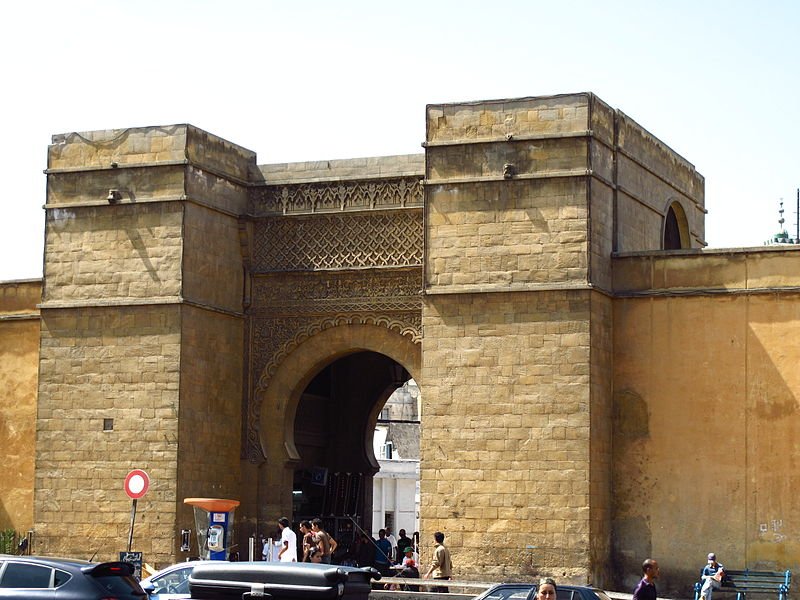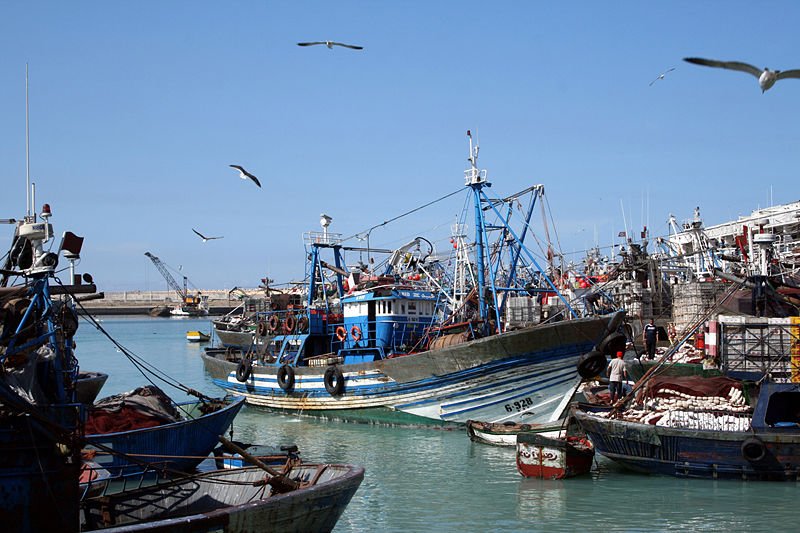Casablanca (Arabic: الدار البيضاء, al Dar al-Bayda) is the biggest city in Morocco as well as its main port. The city covers 324 sq km (125.1 sq mi) and has a population of 2.9 million people (2011 estimate) within a metropolitan area of 3.6 million. The city is the economic and business hub for Morocco. It observes the Western European Time zone (UTC+0) and in summer the Western European Summer Time (UTC+1).
Casablanca is located in the Chawiya plain, the main food-producing region of Morocco. The name Casablanca means "white house" in Spanish. It is believed that the Spanish name was derived from an older Portuguese name for the city, Casa Branca.
 Gate into the medina of Casablanca
Gate into the medina of Casablanca http://commons.wikimedia.org/wiki/File:Entree_medina_Casa.jpg
http://commons.wikimedia.org/wiki/File:Entree_medina_Casa.jpg Sammyday
Sammyday
Casablanca experiences a Mediterranean climate with strong moderating influence of the Atlantic Ocean. The warmest month is August, when the average high temperature reaches 26.7°C (80.1°F). Coldes month is January, when the average low temperature drops to 7.2°C (45°F). December is the wettest month with 146 mm (5.75 in) of precipitation.
The area around Casablanca has been inhabited by Berber tribes since the 7th century BC. There was a port here established by Phoenicians. It was called Anfa. The port became a small independent kingdom of the same name. The area was conquered by the Romans around AD 40 but was returned to local rule after two centuries.
In 1068 the town of Anfa was conquered by the Almoravids. By the 15th century, it became an independent state once again. But as it provided shelter to pirates, the town was destroyed by the Portuguese, which then built a fortress in the area in 1515, and called it Casa Branca.
 Fishing boat in the Port of Casablanca
Fishing boat in the Port of Casablanca http://commons.wikimedia.org/wiki/File:Casablancca_port_de_peche_%281%29.jpg
http://commons.wikimedia.org/wiki/File:Casablancca_port_de_peche_%281%29.jpg Remi Jouan
Remi Jouan
In the 18th century, Sultan Mohammed rebuilt the town with help from the Spanish, and it was then called Casablanca. By the turn of the 20th century, it has grown into a moderate size city of around 100,000 people. The city came under French Protectorate, and was depicted in the 1942 movie of the same name.
After Morocco gained independence, Casablanca developed its tourism industry while at the same time maintained its position as the economic and business center for Morocco. In recent years, the city was hit by suicide bombings linked to al-Queda. This took place in 2003 and 2007.
Visiting Casablanca
The Mohammed V International Airport (CMN) is the biggest airport in Morocco and the gateway to Casablanca. It receives flights from major cities in Europe as well as from New York City, Canada, and many cities in the Arab world and Africa.Places of Interest in Casablanca
- Anfa
Upscale neighborhood of Casablanca, often regarded as the city's Beverly Hills. - Avenue des Forces Armées Royales
Major commercial street in Casablanca, lined with hotels and high-rise commercial buildings. - Boulevard Mohammed V
Main thoroughfare through the commercial heart of Casablanca. - Casablanca Clocktower
Originally built in 1910, this city landmark was demolished and rebuilt in 1940. - Casablanca Port
The main port of Morocco built during the French Protectorate. - Casablanca Twin Towers
A pair of skyscrapers, each 100 meters tall with a podium, this is a major office and shopping complex in the city. - Cathédrale Sacré-Cœur
Catholic Church of the Sacred Heart built in 1930-52 by Paul Tournon in the Art Deco style. - Consulat de France
French consulate building, designed by A Laprade in 1916, at Place Mohammed V. - Corniche d'Aïn Diab
Coastal avenue lined with restaurants, nightclubs, hotels and other upscale establishments. - Église Notre-Dame-de-Lourdes
Catholic Church of Our Lady of Lourdes built in 1956 featuring stained-glass windows depicting the life of the Virgin Mary. - Hassan II Mosque
Completed in 1993, this is the second biggest religious building in the world after the grand mosque of Mecca. - Medina of Casablanca
The original old town surrounded by medieval walls and entered through defensive gates. - Mohammedia
Originally called Fedala, this is a port city between Casablanca and Rabat, home to the most important oil refinery in Morocco. - Musé du Judaïsme Marocain
The Museum of Moroccan Judaism contains Jewish religious objects and other items. - Quartier Habous
The new town built by the French in the 1930s to house Casablanca's growing working class population. - Palais dee Justice
French colonial justice building, designed by J Marrast in 1922, located at Place Mohammed V. - Parc de la Ligue Arabe
A huge park designed in 1919 by A. Laparde featuring stately avenues lined with palm trees. - Place des Nations Unies
The heart of Casablanca new town, where the main boulevards meet. - Place Mohammed V
City square built during the French Protectorate of Morocco is a blend of French architecture with Moorish elements. - Tomb of Sidi Allal el-Kairouani
Tomb to the Muslim patron saint of Casablanca.
 Latest updates on Penang Travel Tips
Latest updates on Penang Travel Tips

Copyright © 2003-2025 Timothy Tye. All Rights Reserved.

 Go Back
Go Back